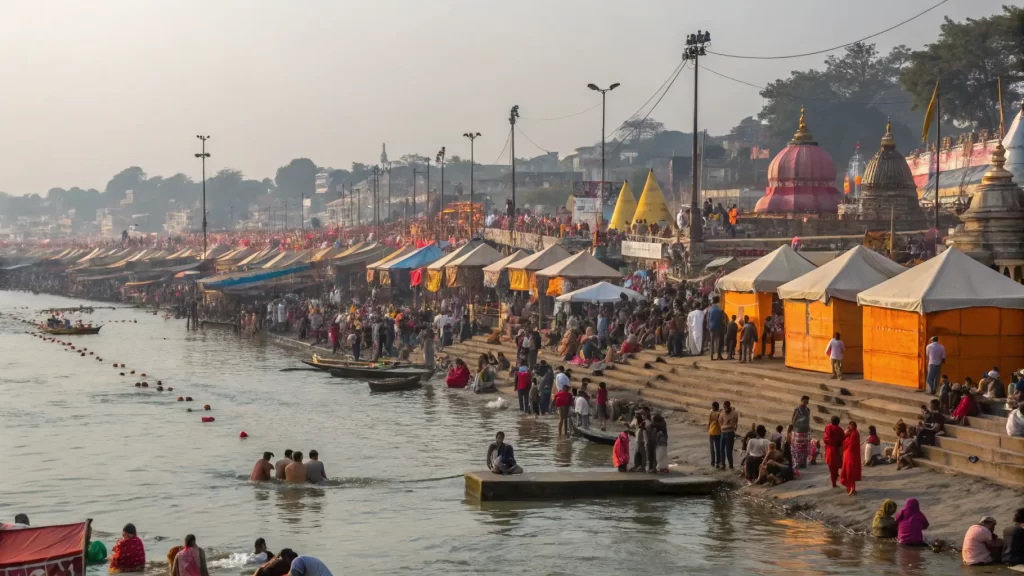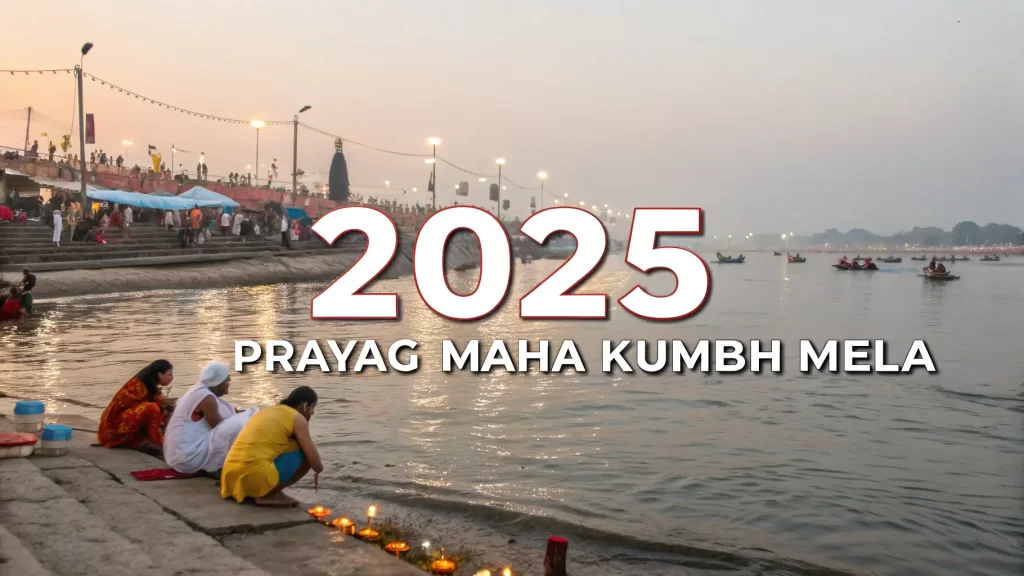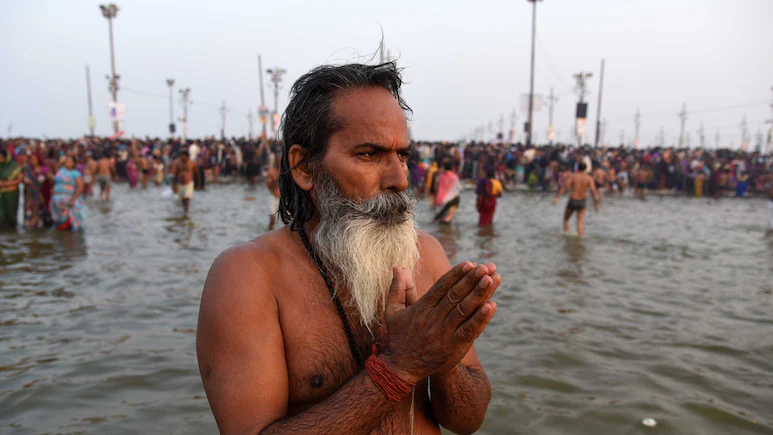The Ultimate Guide to MahaKumbh Mela: History, Significance, and Rituals
Aryan K | February 8, 2025

- Key Takeaways
- What is Kumbh Mela?
- Maha Kumbh Mela 2025 (प्रयागराज महाकुंभ मेला): An Overview
- Historical Significance of Maha Kumbh
- History and Evolution of Kumbh Mela
- Spiritual Practices at Maha Kumbh Mela
- Sadhus and Sannyasis: The Spiritual Leaders of Kumbh Mela
- Key Rituals and Ceremonies
- Cultural Activities and Celebrations
- UNESCO Recognition
- Kumbh Mela and Indian Independence Movement
- Logistics and Planning for Pilgrims
- Hygiene and Cleanliness Initiatives
- Environmental Impact and Sustainability Efforts
- Security Measures
- Budget and Infrastructure
- The Confluence of Faith and Rivers
- Summary
- Frequently Asked Questions
The Mahakumbh Mela is the largest religious gathering in the world, held every 12 years in India. Also known as the festival of the sacred pitcher, it connects to the mythological story of the churning of the ocean, where the sacred nectar was contained in a pitcher that was fought over by the Devas and Asuras. It’s a profound event that draws millions of Hindu devotees for spiritual purification at one of four sacred river sites. In 2025, the event will take place in Prayagraj, where pilgrims will gather at the confluence of the Ganga, Yamuna, and Saraswati rivers. This guide covers the history, significance, and rituals of the Mahakumbh Mela, providing everything you need to know about this extraordinary spiritual event.
Key Takeaways
The Maha Kumbh Mela 2025, scheduled from January 13 to February 26 in Prayagraj, is expected to attract 400 to 450 million pilgrims, making it the largest religious gathering globally.
Rooted in the ancient legend of Samudra Manthan, the festival emphasizes spiritual purification and cultural heritage, and it has been recognized by UNESCO as an Intangible Cultural Heritage of Humanity.
Extensive planning for the event includes robust hygiene, safety, infrastructure, and accommodation measures to ensure a secure and enriching experience for all attendees.
What is Kumbh Mela?
Kumbh Mela is a grand Hindu pilgrimage festival celebrated approximately every 6, 12, and 144 years, making it one of the largest peaceful gatherings in the world. This festival, known as the “world’s largest congregation of religious pilgrims,” is observed at four major pilgrimage sites: Prayagraj, Haridwar, Nashik-Trimbak, and Ujjain. Each location holds its own unique significance, drawing millions of devotees who come to partake in the ritual dip in the sacred waters. This act of bathing is believed to cleanse sins and grant spiritual liberation.
However, the Kumbh Mela is much more than just a religious event. It is a vibrant celebration of community, commerce, education, and entertainment. The festival features a plethora of activities, including religious discourses, mass gatherings of monks, and various cultural performances. The Kumbh Mela is a testament to the rich cultural heritage of Hinduism and its enduring traditions, making it a truly unique and immersive experience for all who attend.
Maha Kumbh Mela 2025 (प्रयागराज महाकुंभ मेला): An Overview

Scheduled from January 13 to February 26, the Maha Kumbh Mela 2025 will take place in Prayagraj, a city known for its spiritual significance. This event, held every 12 years, is anticipated to attract an astounding 400 to 450 million pilgrims, solidifying its status as the largest religious gathering in the world. The sheer scale of this event is a reflection of its profound significance in Hinduism and its power to unite people from diverse backgrounds in a shared spiritual journey, especially during the Kumbh Mela.
For those curious about “कब और कहां लगेगा” or “अगला महाकुंभ कब”, the Kumbh Mela occurs every 12 years at one of four sacred sites. In 2025, Prayagraj will host the Maha Kumbh Mela, attracting devotees to the confluence of the Ganga, Yamuna, and Saraswati rivers. This confluence, or Triveni Sangam, is believed to be imbued with divine energy, making it a fitting venue for such a momentous event.
More than a religious festival, the Maha Kumbh Mela 2025 celebrates life, devotion, and the enduring traditions of Hindu spirituality. The event includes various activities, ceremonies, and rituals aimed at soul purification and spiritual upliftment. From the sacred dips in the holy rivers to the mesmerizing Ganga Aarti, the Maha Kumbh Mela promises an experience that is both spiritually enriching and culturally immersive.
Historical Significance of Maha Kumbh
The origins of the Maha Kumbh Mela are deeply rooted in Hindu mythology and the ancient legend of Samudra Manthan. According to this legend, during the churning of the ocean by the gods and demons, a pot of nectar, or amrita, emerged. This pot is referred to as the sacred pitcher. In the ensuing battle for this nectar, drops fell at four locations on Earth, which are now the sites of the Kumbh Mela. This legend encapsulates the festival’s essence, symbolizing the eternal struggle between good and evil and the quest for immortality.
The practice of the Kumbh Mela dates back to the 8th century, inspired by the teachings of the philosopher Shankara, who advocated for regular gatherings of ascetics for spiritual discourse. These gatherings evolved into what we now recognize as the Kumbh Mela, a confluence of spiritual, cultural, and social dimensions. The festival has grown to embody a wide range of practices, from astronomy and astrology to traditional rituals and community values.
The Maha Kumbh Mela’s significance extends beyond its mythological origins. It celebrates cultural heritage, community, and spiritual unity. Recognized by UNESCO as an Intangible Cultural Heritage of Humanity, the festival underscores the importance of preserving these age-old traditions for future generations. This recognition serves as a reminder of the festival’s role in promoting social cohesion and cultural continuity.
History and Evolution of Kumbh Mela
The history of the Kumbh Mela is deeply intertwined with the legacy of the 8th-century Hindu philosopher and saint Adi Shankara. Adi Shankara is traditionally credited with initiating the Kumbh Mela as part of his efforts to establish monastic institutions (mathas) and promote major Hindu gatherings for philosophical discussions and debates. These early gatherings laid the foundation for what would become one of the most significant religious festivals in Hinduism.
Over the centuries, the Kumbh Mela has evolved significantly. During the British colonial era, the East India Company recognized the economic potential of the festival. They imposed a “pilgrim tax” and levied taxes on the trade that flourished during the event, thereby shaping the modern Kumbh Mela. Despite these changes, the core essence of the festival—spiritual purification and communal harmony—remains unchanged.
Today, the Kumbh Mela is a confluence of spirituality, culture, and social values, attracting millions of pilgrims from around the world. It stands as a testament to the enduring power of faith and the rich cultural heritage of India.
Spiritual Practices at Maha Kumbh Mela
Spiritual practices at the heart of the Maha Kumbh Mela draw millions of devotees seeking purification and divine blessings. A key ritual is the holy dip at the Triveni Sangam, where the Ganga, Yamuna, and Saraswati rivers meet. Bathing here is believed to cleanse all sins and lead to spiritual purification, embodying the transformative power of faith.
The festival begins with the sacred bathing on पौष पूर्णिमा, marking the first significant ritual. Devotees participate in various spiritual activities like yajnas (fire rituals), meditation, and chanting. These practices are not merely symbolic but are deeply rooted in Hindu traditions, offering participants a path to spiritual enlightenment and inner peace.
Another profound practice is Kalpavas, where devotees commit to a period of austerity and spiritual discipline. Participants renounce worldly comforts and engage in daily rituals, prayers, and meditation, reflecting a deep commitment to spiritual growth. The festival concludes with the final bathing ritual on Mahashivaratri, symbolizing the completion of a sacred journey.
Sadhus and Sannyasis: The Spiritual Leaders of Kumbh Mela

Image Source and credit- ndtv.in
At the heart of the Kumbh Mela are the Sadhus and Sannyasis, the revered spiritual leaders who embody the transient nature of life. These ascetics play a crucial role in connecting the spiritual and the mundane, offering devotees a unique opportunity to engage in darshan. Darshan, a profound visual exchange, allows worshippers to symbolically “drink” the deity’s power through sight, fostering a deep spiritual connection.
The Kumbh Mela is meticulously structured into camps, each facilitating access to Sadhus for Hindu worshippers. These camps become centers of spiritual activity, where devotees can seek blessings, participate in religious discourses, and witness the ascetic practices of the Sadhus. The presence of these spiritual leaders adds a profound dimension to the Kumbh Mela, making it a deeply enriching experience for all attendees.
Key Rituals and Ceremonies
Renowned for its elaborate rituals and ceremonies, the Maha Kumbh Mela is imbued with deep spiritual significance. One iconic ritual is the shahi snan, or royal bath, where sadhus and devotees immerse in the holy waters at designated riverbank sites. This ritual is considered the pinnacle of spiritual cleansing, attracting millions of participants who believe it leads to liberation from the cycle of rebirth.
Several key bathing dates are set, with Mauni Amavasya being one of the most auspicious. On this day, up to 100 million pilgrims are expected to gather at the Sangam for a collective act of faith and devotion. The peshwai procession, featuring ascetics with elephants, horses, and chariots, symbolizes the unity and spiritual strength of the religious orders.
The Ganga Aarti, a visually stunning ritual with priests holding lit lamps, creates a mesmerizing display that fosters deep devotion among attendees. Other significant rituals like Shraadh, performed to honor ancestors, underscore the festival’s emphasis on purification and respect for family lineage. These ceremonies collectively contribute to the festival’s rich tapestry of spiritual practices.
Cultural Activities and Celebrations
Beyond spiritual practices, the Maha Kumbh Mela vibrantly celebrates cultural heritage. The festival includes a variety of cultural activities such as pravachans (spiritual discourses), folk performances, and mythological dramas. These activities provide a platform for devotees to deepen their understanding of spirituality and engage with the rich cultural traditions of Hinduism.
Satsang, or spiritual gatherings, offer devotees enlightening discourses from saints and religion leaders, fostering community and spiritual growth. Philanthropic acts like Gau Daan (donation of cows) and Vastra Daan (donation of clothes) reflect the devotees’ commitment to charity and selflessness.
Initiatives like the Swachhata Rath Yatra promote cleanliness and environmental awareness, encouraging public participation. The Deep Daan ritual, where lit earthen lamps float on the river, creates a visually striking and spiritually uplifting experience, symbolizing the devotees’ devotion and reverence. These cultural activities and celebrations make the Maha Kumbh Mela a holistic and enriching experience.
UNESCO Recognition
In 2017, UNESCO inscribed the Maha Kumbh Mela on its Representative List of the Intangible Cultural Heritage of Humanity. This recognition highlights the festival’s significance as a major cultural event in India and its role in preserving cultural heritage. UNESCO’s listing emphasizes the need to safeguard the traditions and practices of the Maha Kumbh Mela for future generations.
UNESCO’s recognition testifies to the festival’s unique blend of spirituality, culture, and community values. It celebrated the festival’s role in promoting social cohesion and cultural continuity, emphasizing the importance of preserving this ancient tradition for humanity.
This acknowledgment elevates the global status of the festival, attracting more international attention and participation.
Kumbh Mela and Indian Independence Movement
The Kumbh Mela played a pivotal role in the Indian Independence Movement, serving as a platform for resistance against colonial rule. The Prayagwal community, closely associated with the Kumbh Mela, was instrumental in seeding and perpetuating the 1857 rebellion against the British. They actively campaigned against the colonial government-supported Christian missionaries and officials who sought to convert Hindu pilgrims to Christianity.
The Kumbh Mela became a symbol of cultural and political resistance, uniting people in their fight for independence. The festival’s significance extended beyond its religious aspects, highlighting the deep-rooted connection between faith and the struggle for freedom. The Kumbh Mela’s role in the independence movement underscores its importance as a cultural and political force in India’s history.
Logistics and Planning for Pilgrims
Attending the Maha Kumbh Mela demands meticulous planning and preparation. Pilgrims should book their transportation well in advance due to the high demand and the influx of attendees. Local transportation options like shuttles, buses, and e-rickshaws will be available, but vehicle access will be limited in some areas, making it essential to familiarize oneself with maps and use GPS for navigation.
Accommodations range from hotels to temporary tent facilities. Early reservations are highly recommended to secure a spot. A temporary city, Mahakumbh Nagar, will cater to the needs of millions of visitors, offering various accommodations, including luxury tents. Lost and Found centers with digital registration will help reunite lost pilgrims with their families, ensuring a safe and organized experience.
Pilgrims should pack weather-appropriate clothing, especially warm layers for the colder months, along with essentials like a first aid kit and a water bottle. Multilingual signboards will aid navigation, and travelers are encouraged to use these resources for a smooth and fulfilling pilgrimage.
Hygiene and Cleanliness Initiatives
Hygiene and cleanliness are top priorities at the Maha Kumbh Mela 2025. A comprehensive sanitation plan includes 12,000 Fiber Reinforced Plastic toilets with septic tanks and 20,000 community urinals to ensure hygienic facilities for pilgrims. There will be one sweeper for every ten toilets, supported by a dedicated monitoring system to maintain cleanliness.
Over 20,000 trash bins are strategically placed throughout the event area to encourage effective waste segregation and disposal. A rigorous waste management system, including 37.75 lakh liner bags, has been established for organized waste collection. The fairgrounds have been declared plastic-free zones, banning single-use plastics to protect the environment.
Sanitation workers, known as Safai Mitras, will receive essential support like housing and education for their children, ensuring their well-being while they perform their duties. Rapid sanitation teams will be deployed after major bathing rituals to ensure quick cleanup and maintenance of public toilets, contributing to a clean and healthy environment.
Environmental Impact and Sustainability Efforts
The Kumbh Mela, with its massive influx of pilgrims, has a significant environmental impact. The festival generates a substantial amount of waste, including plastic, food waste, and human waste. To address these challenges, the Indian government and local authorities have implemented various sustainability efforts aimed at minimizing the environmental footprint of the festival.
Comprehensive waste management systems, recycling programs, and eco-friendly infrastructure are key components of these efforts. The festival grounds are equipped with numerous trash bins to encourage proper waste disposal, and single-use plastics are banned to protect the environment. Additionally, many organizations and individuals are actively promoting sustainable practices, such as using biodegradable materials and reducing waste generation.
These initiatives reflect a growing awareness of the need to balance the spiritual and cultural significance of the Kumbh Mela with environmental responsibility. By adopting sustainable practices, the festival aims to preserve its sacred sites for future generations while continuing to be a beacon of faith and devotion.
Security Measures
Safety is paramount, and advanced security measures are in place to protect the millions of attendees. AI-powered surveillance, including around 2,700 AI-enabled cameras and drones, will monitor the expansive event area to ensure safety. Approximately 40,000 police officers and specialized security forces will be deployed to maintain order and manage the large crowds.
Temporary police stations and checkpoints will be established throughout the event area to manage the flow of pilgrims and respond to incidents. A multi-disaster response vehicle equipped with advanced tools will swiftly handle emergencies, and remote-controlled life buoys will assist individuals in distress.
These comprehensive security measures ensure a safe and secure environment for all participants.
Budget and Infrastructure
With an estimated budget of ₹6,382 crore, the Maha Kumbh Mela 2025 reflects the scale and importance of the event. Authorities have created a temporary city covering 4,000 hectares to manage the influx of pilgrims, ensuring all necessary facilities and services are available. The government has allocated ₹6,990 crore for 549 infrastructure projects, including the renovation and beautification of 92 roads to improve accessibility.
Thirty pontoon bridges are being constructed with over 3,300 pontoons to facilitate the movement of pilgrims across the riverbanks. More than 2,69,000 checkered plates will be laid for pathways within the Mela area to ensure safe and orderly navigation for attendees.
These extensive infrastructure projects highlight the commitment to providing a seamless and enriching experience for all visitors.
The Confluence of Faith and Rivers
Held at the Triveni Sangam, where the Ganga, Yamuna, and mythical Saraswati rivers converge, the Maha Kumbh Mela creates a site of immense spiritual significance. This confluence, considered the holiest of all pilgrimages, embodies the essence of faith and devotion, drawing millions of pilgrims who believe that bathing in these sacred waters will cleanse them of their sins and grant them spiritual liberation.
The best time to visit the Triveni Sangam is between October and March, coinciding with pleasant weather and the Magh Mela, another significant religious event. The convergence of the rivers at this sacred site symbolizes the union of physical and spiritual realms, making the Maha Kumbh Mela a profound experience of faith and spirituality for all who attend.
Summary
The Maha Kumbh Mela 2025 promises to be an unparalleled spectacle of faith, culture, and spirituality. From its deep-rooted historical significance and UNESCO recognition to the intricate rituals and vibrant cultural activities, every aspect of the festival is a testament to the enduring power of tradition and devotion. The meticulous planning, hygiene initiatives, and advanced security measures ensure a safe and enriching experience for all pilgrims. As we prepare for this monumental event, let us celebrate the confluence of faith and rivers that define the Maha Kumbh Mela, inspiring millions to seek spiritual enlightenment and communal harmony.
Frequently Asked Questions
Is 2025 Maha Kumbh or Kumbh?
The event in 2025 is the Maha Kumbh, an extraordinary pilgrimage that attracts millions of devotees. It takes place in Prayagraj and is marked by large gatherings and religious significance.
What is the 144 year Maha Kumbh?
The 144-year Maha Kumbh is the most auspicious Kumbh Mela, celebrated when the Moon, Sun, Mercury, and Jupiter align. This rare event marks a significant Hindu pilgrimage, drawing the largest human gathering in the world.
When will the Maha Kumbh Mela take place in 2025?
The Maha Kumbh Mela is set to occur from January 13 to February 26, 2025. This significant event offers a unique opportunity for spiritual reflection and cultural celebration.
Where is the Maha Kumbh Mela held?
The Maha Kumbh Mela is held at the Triveni Sangam in Prayagraj, where the Ganga, Yamuna, and the mythical Saraswati rivers meet. This location is of great religious significance for devotees.
How many pilgrims are expected to attend the Maha Kumbh Mela in 2025?
Approximately 400 million pilgrims are anticipated to attend the Maha Kumbh Mela in 2025. This significant gathering reflects the deep spiritual engagement of the devotees.
Disclaimer
This article is intended for informational purposes only. It provides an overview of the Maha Kumbh Mela, its history, significance, and related events. Readers are encouraged to verify details and consult official sources or authorities for the most accurate and up-to-date information regarding the festival. The content should not be considered as professional or official advice.
Recent Posts

January 12 Zodiac Sign: Capricorn Personality, Traits, and More
Aryan K | March 11, 2025

Understanding Gautama Buddha: From Prince to Enlightened One
Aryan K | March 11, 2025

How Compatible Are Aries and Taurus in Love?
Aryan K | March 11, 2025

The September 22nd Zodiac Sign: Love, Career & Personality Insights
Olivia Marie Rose | March 11, 2025

Italian Baby Names: Unique, Traditional, and Modern Picks
Olivia Marie Rose | March 11, 2025
Topics
- 4 Digit Angel Numbers
- 5 Digit Angel Numbers
- 6 Digit Angel Numbers
- Astrology and Birth Charts
- Business Astrology
- Career Astrology
- Celebrities and Personalities Astrological Profile
- Children Astrology
- Chinese Astrology
- Different Angel Numbers Meaning
- Double Digit Angel Numbers
- Dreams Interpretation
- Festivals
- Finance Astrology
- Find Baby Names
- Find Best Astrologers
- Gemstones and Birthstones
- Janam Kundli Chart
- Love Astrology
- Marriage Prediction Astrology
- Nakshatra (Constellations)
- Numerology
- Pet Astrology
- Rudraksha Beads
- Single Digit Angel Numbers
- Spirit Animals
- Spirituality and Positivity
- Symbolism
- Tarot Cards
- Triple Digit Angel Numbers
- Understanding Hinduism
- Vastu Shastra
- Vedic Astrology
- Western Astrology
- Yoga and Meditation
- Zodiac Sign Date Calendar
- Zodiac Signs
- Zodiac Signs Compatibility
